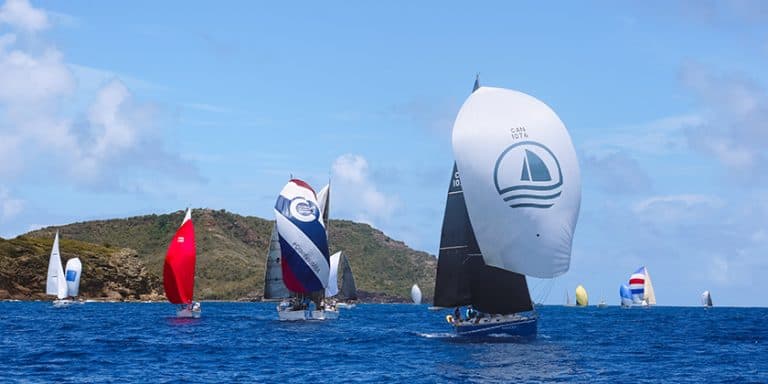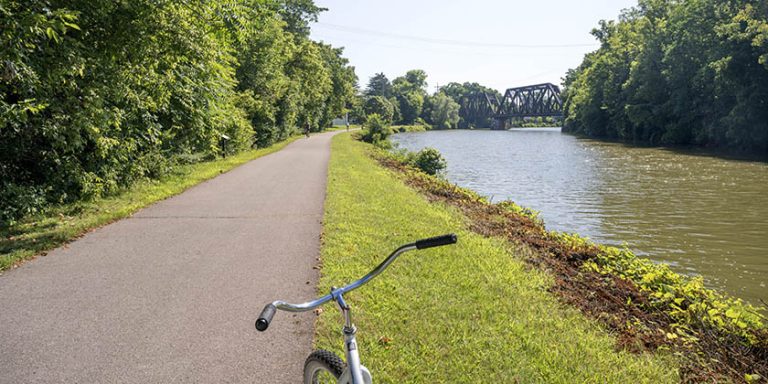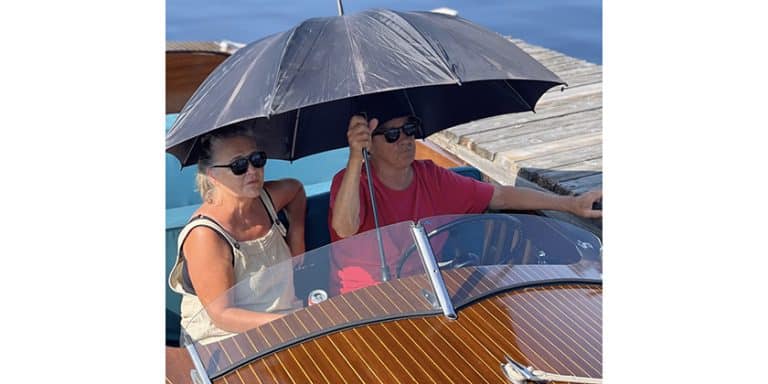Salt Spring Island with Gourmet Food and Drink
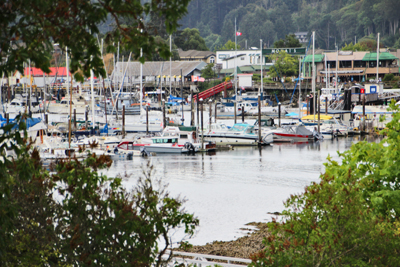
Text and Photos by Marianne Scott
Salt Spring Island, the largest among the Gulf Islands, has a certain mystique—much of it having to do with locally produced food. It started thousands of years ago when the Coast Salish First Nations used the Island as a summer camp, collecting wild foods while also processing the abundant sea food for winter sustenance. In the 19th century, five main groups settled here and began farming: Northern Europeans—some of whom had abandoned gold rush dreams; Hawaiians brought here by Vancouver Island’s second governor, James Douglas; Black Americans who left California to find freedom and dignity; and Japanese who liked the climate for farming. It’s a temperate rain-forest climate, with wet winters and hot, dry summers. Farms continue to dot the landscape. An enterprising couple have even planted a successful olive grove with a plentiful harvest in 2019. Who would have imagined “Made in Canada” olive oil?
Captain Passage leads boaters to Ganges, Salt Spring’s “capital,” and is one of our favourite waterways. We’ve hooked down in several anchorages, as well as docked. This time, we arrived in late summer on a brilliant day, the water transparent, the chain of islands on starboard full of birdlife, a few leaves turning golden among the jade-green conifers.
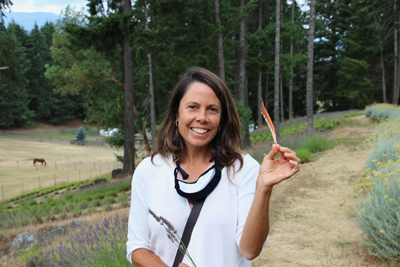 Culinary Tour leader Carolyn Flam Sharp holding lavender and a lucky feather at the Lavender and Black farm.
Culinary Tour leader Carolyn Flam Sharp holding lavender and a lucky feather at the Lavender and Black farm.
Ganges Marina is conveniently located near the town’s shops and restaurants. Unfortunately, Covid-19 had cancelled the Saturday Market, normally one of Ganges’ great attractions featuring local foods, crafts and music. I wandered around in the downtown area, peeking in at the wonderful art galleries and Mouat’s Trading Co., but missed the bustle of the usual summer tourist season.
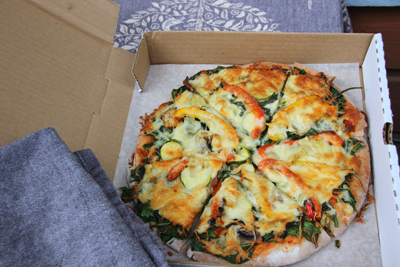
My gluten-free lunch pizza.
For that reason, I signed up for something different. While my husband made a boat repair, I went on the Salt Spring Culinary Tour. It was a good decision. I met the tour owner, Carolyn Flam Sharp, at the dock and we climbed into her spacious BMW SUV. Her company, GOPacGolf, also organizes personalized golf vacations that may also include the culinary tour. Normally, Carolyn runs three customized culinary tours a week from June through September. The tours’ itineraries may vary, depending on customer preference. If people want to experience and taste farm products, the tour differs from those wishing for introductions to Salt Spring wine and spirits producers. This time I was the only guest; we physically distanced by my sitting in the rear seat and both of us wearing masks when in the car’s confines.
On the way to our first stop, I learned more about the Island. It’s a highly diverse community. In the 1960s and ‘70s, Salt Spring was a popular destination for hippies and US draft dodgers, many of whom stayed raising livestock and establishing small businesses. They went organic decades before supermarkets decided it was trendy. Artists and artisans number in the hundreds. But not only the brown-eggs-and-beads people discovered the pleasures of island life. Recently, Salt Spring-based InDro Robotics was the first Canadian company to employ drones to quickly deliver medical supplies to the more isolated islands. In addition, wealthy people and well-off retirees wishing to share the less hectic lifestyle and experience “island time” built million-dollar homes and upscale condos on the water. One benefit of attracting the well-heeled is that they support local artisan foods, including the delicacies we tasted on our tour.
Our first stop was located on a glorious, southwest-facing sloped hill—the Lavender and Black farm. Carolyn and I were greeted by Ben, who with his wife, Awatief, have spent the last five years building the certified-organic farm. Ben toured us around the two-acre planted grounds, where lavender plants are woven around the trees and moistened with drip irrigation. “Of the 450 lavender varieties,” he said, “50 are used commercially. Our 4,000 plants are either English or French lavender. English is sweeter, best for cooking. The French, with its bigger flowerhead, is used in scented products, like sachets, botanical fragrances, essential oils and balms.”
 Moonshine Mama’s fuses healthy ingredients into immune-boosting elixirs.
Moonshine Mama’s fuses healthy ingredients into immune-boosting elixirs.
The farm also grows immortelle (Helichrysum), an everlasting plant whose yellow flowers are used in dried bouquets, herbal medicine, and recently, in essential oils for skin care. Lavender and Black distills its essential oils in an old-fashioned copper alembic still. It’s a labour-intensive art: to produce 300ml of essential oil, Ben loads 17 kilos of French lavender flowers into the still to begin the distilling process. To stock their on-site and on-line store, the process is repeated many times. After our tour, Awatief offered us rooibos tea with delectable lavender-laced madeleines and chocolate.
Mira Tusz and Daniel Dragert founded their winery, Kutatás, in 2016. Both of Hungarian descent, they named their winery after the Hungarian term, “exploration” or “quest.” Mira, whose microbiology degree is useful in the fermentation of grapes, describes their approach to winemaking, which includes pressing their grapes with the stems, and developing their own yeasts, thereby imparting each of their wines with a unique flavour. Their wines include Pinot Grigio, Pinot Gris, Ortega and three types of Pinot Noir. I sampled several (small) delicious amounts from the bottles lined up in the welcoming tasting room, then Mira showed us to a part of their seven-and-a-half acres of vines. The vines lined up in straight rows reaching well above our heads and were loaded with ripening grape clusters. She explained how judicious—and constant—pruning helps these clusters grow.
Carolyn deftly drove us across Salt Spring’s hilly and curvy roads to two food purveyors located next door to each other. The first, Laughing Daughters, where we had lunch, produces only gluten-free baked goods. The second, Moonshine Mama’s, produces “elixirs” designed to boost immune systems. These enterprises both grew out of health issues: Judy Drzymala discovered she had celiac disease when gluten-free food was unpalatable. “It tasted like cardboard,” she writes on her website. When her daughters found they had the same auto-immune disease, Judy bought a small home-based gluten-free bakery and expanded it with tasty stuff both the family and customers could eat. I munched my first gluten-free pizza and I’d happily return for more if I lived on Salt Spring. Judy also presented us with a small blueberry pie—somehow the baking team has found a way to produce yummy baked goods without that debilitating wheat protein.
With our pizza, we quaffed one of Moonshine Mama’s delightful turmeric elixirs—a drink owner Melinda Divers developed after being diagnosed with cancer. Feeling depleted and with her immune system at a low point, she researched organic ingredients that would boost her energy level. Fresh turmeric root is her top ingredient—it’s a cousin of ginger—and contains curcumin, believed to be a powerful antioxidant. She also includes ginger, lemon and honey in her recipes; they’re all anti-inflammatories. She developed the drinkable elixirs to make it easy to imbibe these health boosting potions every day. Moonshine Mama’s has grown into a family affair—Melinda’s husband, daughter, and some friends, have joined the enterprise.
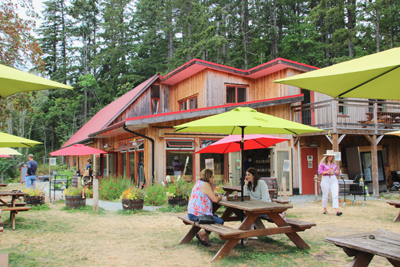 Salt Spring Wild’s cidery, restaurant and store.
Salt Spring Wild’s cidery, restaurant and store.
Back in the BMW, Carolyn chauffeured us to our penultimate stop: Salt Spring Wild—Hard Cider Untamed. I’d already noted the many apple trees growing wild alongside the roads. They may be a century old. When non-Indigenous people settled Salt Spring, orcharding became so popular that the Island supplied apples to large segments of western Canada. But orchards were abandoned or repurposed and apple harvesting declined. Nevertheless, apple trees can survive on their own and dozens of varieties endure. (The Island’s apple heritage is celebrated at the annual fall Apple Festival.) So after former philosophy student Mike Lachelt and sculptor Gerda Lattey met and spied an apple orchard, they founded the cidery in 2014. They harvest the apples from the numerous wild trees, nearby orchards and their own apple trees. Thus their hard ciders are a unique blend of heritage apples and more modern varieties. They also blend their ciders with other fruits, such as plum, elderberry, apricot and saskatoon berry. They even age rosehip-flavoured cider in oak barrels.
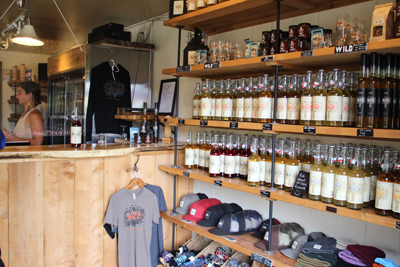 Inside the Salt Spring Wild store.
Inside the Salt Spring Wild store.
Carolyn and I landed on a picnic table and we quickly received a flight of ciders—a dry cider, a semi-dry, a pear cider, the Farmhouse Scrumpy and a pineapple-flavoured cider. It was the first time I’d tasted cider made from pear, and I’ve definitely put it on my to-buy list. Having recently feasted on our pizza, we passed the food also available, although the cheese-and-charcuterie boards and poached figs stuffed with Cambozola held appeal.
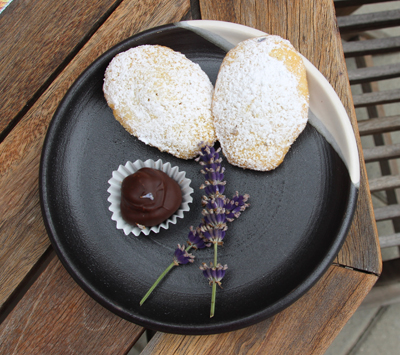
Lavender-laced madeleines and chocolate.
To complete our culinary adventure, we drove up a curving driveway to the Salt Spring Island Cheese Company run by David Wood since 1996. He’d been renowned for his Toronto gourmet store. But he and wife Nancy wanted to raise their family in a more bucolic environment, so they relocated and focused on establishing a goat-cheese factory. Today, well established in his craft, David buys his milk from regional producers. The cheese factory produces four types of goat cheese—fresh chèvre, feta, Romelia and Juliette. Placards spread around the factory answer the basic questions about cheese making: take pasteurized goat milk, add rennet and let it set in a vat until it coagulates. The end product, which takes about three days, is a soft, fresh piquant cheese packed in clear plastic cups, some spiced with basil, pepper, garlic or colourful flowers. In the shop next door, we tasted several samples. I particularly like the peppercorn version.
 Future Kutatas wine.
Future Kutatas wine.
Shortly afterwards, we arrived back in Ganges. I’d thoroughly enjoyed the day and Carolyn’s company and organizational skills. Reflecting on my edible day, I appreciated the loving labour that goes into all these handmade foods and drinks, and admired the owners’ entrepreneurial spirit and their dedication to their craft.
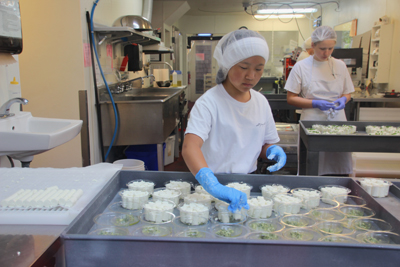 Stuffing goat cheese rolls into containers at Salt Spring Cheese Co.
Stuffing goat cheese rolls into containers at Salt Spring Cheese Co.
For me, taking Carolyn’s Culinary Tour overcame the only drawback to cruising—lack of land transportation. Epicurus, the Greek philosopher who extolled the virtues of good eating and drinking, would have approved.
If you go:
Ganges Marina— gangesmarina.com/
Salt Spring Marina—saltspringmarina.com/
Harbour Authority of Salt Spring—saltspringharbours.com/ganges-harbour/
Salt Spring Culinary Tour—ssifoodtour.gopacgolf.com/ and www.gopacgolf.com/
Lavender and Black—lavenderandblack.ca/#/
Kutatás Winery—kutataswines.com/
Laughing Daughters—laughingdaughtersglutenfreefoods.com/
Moonshine Mama’s—moonshinemamas.ca/
Salt Spring Wild—saltspringwildcider.com/
Salt Spring Island Cheese Company—saltspringcheese.com/
Culinary Tour leader Carolyn Flam Sharp holding lavender and
a lucky feather at the Lavender and Black farm.
My gluten-free lunch pizza.

